| Richard Marmo's SCALEWORLD |
This is the second anniversary of Internet Modeler…and Scaleworld. Over the course of those two years, you've read reviews and construction articles on a wonderfully diverse range of kits and accessories. In the view of many, we modelers are reveling in the midst of a golden age. And, depending on the subject and your perspective, there's certainly justification for that opinion.
Major manufacturers are producing excellent kits, including some we thought we'd never see (such as the 1/48 Swordfish from Tamiya and the 1/48 B-25B and 1/48 B-25C from Accurate Miniatures). Revell-Monogram is offering the car enthusiast everything from Snap-Tites to pre-decorated (in the ProFinish line) to ProModeler glue kits. Similar comments apply to most other genre.
When it comes to resin and injected aftermarket products, the avalanche is such that you don't stand a chance of keeping up. Same for decals and publications.
But there may be a shadow on the land. The question is whether it will wind up having a positive or negative effect.
First and foremost is the fact that relatively few youngsters become deeply interested in model building. Many reasons are given, but the bottom line is that there are so many more things vying for their attention than even existed 30 or 40 years ago. Video games and Play Stations, along with computers and the internet are obvious 'culprits', but that's only the tip of the iceberg. Most enthusiasts or 'serious modelers' are over 30, frequently way over 30. So what happens when they're gone?
Then there are the various laws, state, local and otherwise, that prohibit anyone under 18 from buying or possessing spray paint or glue. Depending on how the law is written, it can be a felony for parents to buy the required paint or glue and then give it to their child for use on a model project. Of course, the laws were originated to combat graffiti and glue sniffing. So how effective are the laws? You still see spray painted graffiti on walls and the glue sniffers are now sniffing other chemicals that have an even worse effect on the body/brain. Go figure.
Finally, there's the question of the collector effect. There seems to be a trend toward completely finished models that are simply removed from the box, looked at adoringly and then placed on a shelf. While this category is usually found in the toy car/diecast area, it's now showing up in the form of prefinished plastic and metal kits. Though they certainly qualify as models, are a lot cheaper than a similar offering from Franklin Mint and look great when you're done, the fact that everything is pre-finished eliminates the development of many model building skills.
Manufacturers claim that these type of kits help draw new modelers into the hobby. The rationale is that after they've built a few Snap-Tites, they'll move up to the next level of pre-finished kits, then the pre-finished metal kits and finally graduate to the conventional glue kits that we're all familiar with. It's certainly a valid concept if it works as projected.
So…are we in the midst of a glorious golden age that proves model building is a dynamic, growing hobby? Or are the best times now behind us?
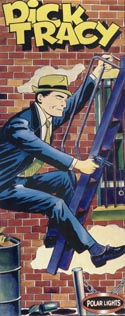 POLAR
LIGHTS has recently released a slew of new kits. They run the gamut
from figures to dinosaurs with the first one being a much anticipated
repop of that famous comic strip detective, Dick Tracy.
POLAR
LIGHTS has recently released a slew of new kits. They run the gamut
from figures to dinosaurs with the first one being a much anticipated
repop of that famous comic strip detective, Dick Tracy.
With all parts molded in a light cream styrene, the kit's everything you've come to expect in an Aurora repop. Instructions and the conventional top over bottom box utilize the familiar retro appearance. Parts are contained in two bags, one for Dick Tracy and a second for all components that make up the diorama style display base.
The base takes the form of a section of a brick building, adjacent alley and fire escape that Tracy is descending in the pursuit of a dirtbag. Details include bars on the window, a battered 55-gallon drum, chains, stancions and assorted trash. Scale, probably because of the diorama base, is around 1/16. Price is $16.99.
Anyone who followed the exploits of this intrepid lawman (and you know who you are) will have to add this kit to their collection.
In the 50s and 60s, AURORA had a virtual lock on figure kits, especially movie monsters and horror figures. And, of course, those of us who cut our teeth on aircraft kits did a lot of it on AURORA models. Who could ever forget their bright yellow Zero or dark red Messerschmitt Bf-109E. Once you had built them and they'd worn out their welcome, they made great targets for BB rifles!
Well, the AURORA label is back…at least where movie monsters and horror figures are concerned. POLAR LIGHTS has obtained exclusive rights to use of the AURORA logo.
Three of the first kits to appear under the AURORA label will delight devotees of classic Japanese monster movies. You know the ones…hoky beyond belief with special effects that look more a kid stomping around in a sandbox than a film made for the theatre. But for all their crudeness they were a heckuva lot of fun.
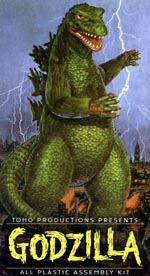 Probably
the one that comes immediately to mind is the original Godzilla. A completely
unbelievable giant lizard with blood on his hands (claws?) and murder
in his eyes, his existence the result of indescriminate nuclear testing.
You might even call him the world's first environmentalist!
Probably
the one that comes immediately to mind is the original Godzilla. A completely
unbelievable giant lizard with blood on his hands (claws?) and murder
in his eyes, his existence the result of indescriminate nuclear testing.
You might even call him the world's first environmentalist!
Unbelievable he might have been, but it was a hoot watching a guy in a rubber suit stomp all those miniature towns into kindling. And think of the number of professional modelbuilders that movie and all of its sequels supported! Sequels? More than I can recall, with the latest version (Godzilla 2000) nearing release.
Godzilla changed over the years into something that fans of the original movie wouldn't have recognized. Fortunately (or unfortunately, depending on your preference), Godzilla 2000 returns to the spirit of the original. From the few promos I've seen, Godzilla himself (herself?) takes virtually the same physical form as the original, a development that couldn't be better timed.
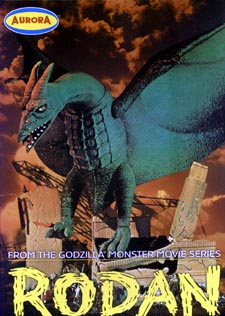 If you've
ever built the AURORA Godzilla kit from the past, then you know exactly
what to expect…except maybe the color. This time around, parts (which
are all in a single bag) are molded in an eye-blinding Jello Lime Green.
Oh, well, at least it keeps the parts from getting lost on your bench…
til you get it built and primed.
If you've
ever built the AURORA Godzilla kit from the past, then you know exactly
what to expect…except maybe the color. This time around, parts (which
are all in a single bag) are molded in an eye-blinding Jello Lime Green.
Oh, well, at least it keeps the parts from getting lost on your bench…
til you get it built and primed.
Produced as a glue kit, there are some 33 parts (including the base and nameplate) and the expected retro style instructions and box. $16.99 ain't bad for a trip to the past.
If the Godzilla kit left you wanting more movie monsters, particularly something related to Godzilla, consider two others, Rodan and King Ghidorah.
These two kits have been reverse-engineered so that they can be produced as snap kits. If you don't care for snap kits (and I don't), there's an easy enough solution…just add some Ambroid ProWeld or similar solvent in the usual manner and assemble like a conventional kit. Instructions have the flavor but not the direct retro appearance of the old AURORA style and the boxes…well, the boxes are different.
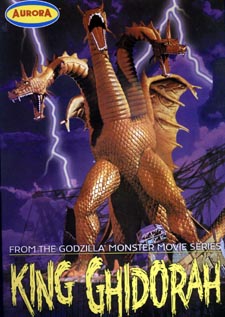 While
the boxart has the retro feel to it, the boxes themselves are distinctly
modern. For reasons that are directly controlled by economics, both Rodan
and King Ghidorah are packaged in clamshell style boxes. Do I like clamshell
boxes? Absolutely not, mainly because they're flimsy, take twice as much
space on the bench and don't stack worth a flip after they've been opened.
Do I understand the reasons for using clamshells? Yes. And a case can
certainly be made when you consider that both kits sell for $11.99. Use
a sturdier, conventional box and the price would go up at least a dollar
or two if not more.
While
the boxart has the retro feel to it, the boxes themselves are distinctly
modern. For reasons that are directly controlled by economics, both Rodan
and King Ghidorah are packaged in clamshell style boxes. Do I like clamshell
boxes? Absolutely not, mainly because they're flimsy, take twice as much
space on the bench and don't stack worth a flip after they've been opened.
Do I understand the reasons for using clamshells? Yes. And a case can
certainly be made when you consider that both kits sell for $11.99. Use
a sturdier, conventional box and the price would go up at least a dollar
or two if not more.
Both kits are molded in a light cream/tan styrene. Rodan's 25-odd parts are contained in two bags while the 35-odd components of King Ghidorah's are found in a single bag. Assembly should be pretty staightforward, but it's the painting that'll separate the men from the boys. You'll find that both kits, with some time spent on proper painting, can turn into some very nice additions to your movie monster collection. King Ghidorah, in particular, is an excellent kit to practice your drybrushing techniques on.
Remember the Planet of the Apes movie series? What about the old ADDAR kits that featured four of the main ape characters? If you've been wishing you could get your hands on those kits for old time's sake, now you can.
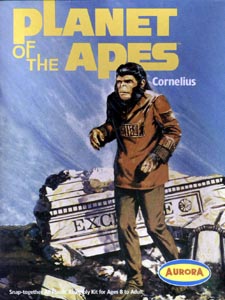 .......
.......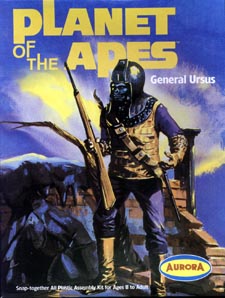
Under the AURORA label, Cornelius, General Ursus, Dr. Zaius and Dr. Zira can take up residence in your showcase. In much the same manner as Rodan and King Ghidorah, parts are molded in light crème, instructions have the flavor of the retro style and all four of the boxes are….clamshell.
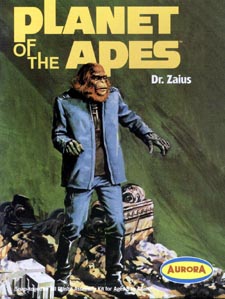 .......
.......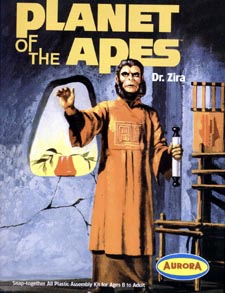
They've all been reverse-engineered as snap kits, have somewhere between 16 and 24 parts and sell for $11.99 each. Again, your skill with a paintbrush (and drybrushing techniques) will determine the final quality of each model.
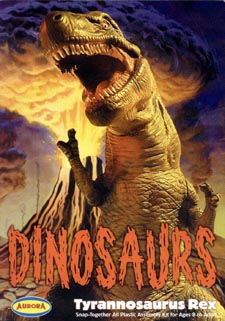 Dinosaurs
have developed quite a following of late. Available kits range all the
way from high dollar resin products that show up in natural history museums
to low priced 'models' that are lucky to qualify as toys. And everything
in between.
Dinosaurs
have developed quite a following of late. Available kits range all the
way from high dollar resin products that show up in natural history museums
to low priced 'models' that are lucky to qualify as toys. And everything
in between.
With that as background, it's particularly interesting that three brand new offerings from AURORA are dinosaurs. Even better is the fact that they are very nice indeed. As I said, these are completely new efforts, created from original sculpts by Scott Hensey.
The subjects in question are a Tyrannosaurus Rex, Triceratops and a Pteranodon (what you used to know as a Pterodactyl) and they've been produced as snap kits. Instructions are simple but sufficient and all boxes are the clamshell type. Each kit is comprised of some 20-odd parts that includes a base. There's also a die-cut color background that forms the bottom of the box. It's intended to be cut out and mounted on the molded base to produce a realistic color backdrop.
Quality is excellent with some very nice skin detail. If anything's missing, it's that the only painting instructions refer you to the boxtop. When you consider that no one really knows what colors or patterns actually appeared on dinosaurs, it's almost anything goes …as long as you make the final patterns look natural. Me? I'd go prowl around at the library and bookstores. There's a wealth of dinosaur publications available, most of them with excellent color illustrations that are based on the latest information. In fact, one that I have is called The Ultimate Dinosaur Book by David Lambert. How good is it? Consider that I first found it at the library and thought so much of it that I bought a copy for myself. It sells for $29.95 but I think I got it for less than $10 on sale.
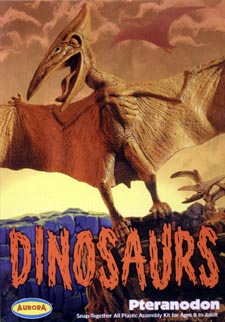 ......
......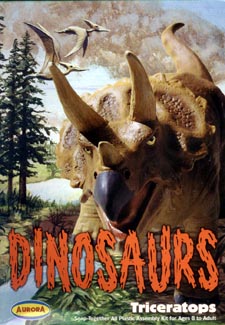
The T-Rex is in a typical attack position with his jaws gaping open and the Triceratops is in an interesting pose that has it's head and tail up with the mouth partly open. It's as if it's sensing danger but isn't sure yet what that might be. But it's the Pteranodon that'll get your attention. Perched on top of a vertical cliff preparing to launch itself into the air, it looks eerily human-like. Standing on two legs, bent at the knees, with the skeletal bones of the arms partially embedded in the spread wings, it's hard to ignore. Visitors to your model room won't be able to.
If you like dinosaurs, these are definitely worth your consideration. And the price, at $11.99 each, is most reasonable.
If you prefer something more applicable to the modern world, take a look at some of the latest car kits from AMT/Ertl. All three are 1/25 scale, level two glue kits and range from a production car to a show car. Price is a most reasonable $11.00 each.
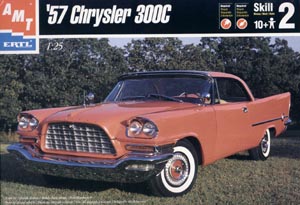 First
up is a street stock kit of the 1957 Chrysler 300C. Molded in light gray,
most of the parts are captured in three bags. The one-piece body is not,
nor are the red lenses, tires or whitewall inserts. Since this is a stock
production version, there are no options at all. About the only decision
you have to make is whether or not to leave the hood open. Considering
the nicely detailed 392 motor that's sitting in the engine room, that
wouldn't be a bad move. Just keep in mind that if you install the hinges
to support the hood in an open position, it'll have to stay that way permanently.
Eschew the hinges and the hood becomes removable but not hinged.
First
up is a street stock kit of the 1957 Chrysler 300C. Molded in light gray,
most of the parts are captured in three bags. The one-piece body is not,
nor are the red lenses, tires or whitewall inserts. Since this is a stock
production version, there are no options at all. About the only decision
you have to make is whether or not to leave the hood open. Considering
the nicely detailed 392 motor that's sitting in the engine room, that
wouldn't be a bad move. Just keep in mind that if you install the hinges
to support the hood in an open position, it'll have to stay that way permanently.
Eschew the hinges and the hood becomes removable but not hinged.
The instructions are quite thorough, particularly considering that they're strictly illustration style. Parts are even identified by their proper name and with color callouts besides. There's also a small decal sheet, most of which is used on the instrument panel. Keep in mind that the 300C introduced a new transmission for that year…a three-speed automatic pushbutton design. That alone makes this kit worthy of inclusion in your production car collection.
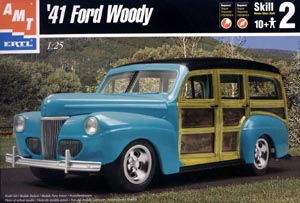 Prefer
something a little fancier than street stock? Then take a look at the
1941 Ford Woody (that's a station wagon for the uninitiated). At first
glance, I thought it was a pure stock station wagon, which, since I happen
to love station wagons, had my creative juices flowing. Turns out that
it's a customized Woody.
Prefer
something a little fancier than street stock? Then take a look at the
1941 Ford Woody (that's a station wagon for the uninitiated). At first
glance, I thought it was a pure stock station wagon, which, since I happen
to love station wagons, had my creative juices flowing. Turns out that
it's a customized Woody.
If you like customized cars, this little puppy winds up being very attractive. There are more custom parts on it than I have room to mention, but includes such things as a custom front axle, quick change rear axle, fuel injected flathead engine, custom chrome wheels, low profile Goodyear tires and on and on. And before I forget, a surfboard.
Kit parts are molded primarily in light gray with the majority of them being contained in four bags. The main body and Goodyear tires are not. Instructions follow the format described for the 300C and there's a sheet of decals that include woodgrain for the insert sections of the wood body panels. All you have to do is paint the inserts a lightish medium tan and then add the decals. It's a rather neat way of duplicating the effect you can get with drybrushing.
As with the 300C, there are no options and the front wheels are not poseable. The hood is removable but not hinged. Unlike the 300C, you can't install the hood permanently open on scale hinges.
Prefer a straight show car instead? This one, based on a 1939 Chevy,
is strange enough to have me actually thinking about building it…and that's
saying 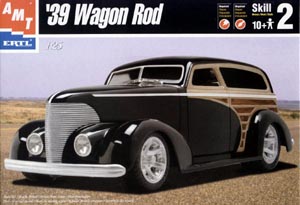 something.
Combining a 1939 Chevy two-door with a woody station wagon and more than
a little imagination results in the '39 Wagon Rod. Dark, low and ominous,
sporting huge chrome wheels, a massive chrome grill and low-placed bullet
headlights, it looks like a refugee from a parallel universe where gangsters
rule.
something.
Combining a 1939 Chevy two-door with a woody station wagon and more than
a little imagination results in the '39 Wagon Rod. Dark, low and ominous,
sporting huge chrome wheels, a massive chrome grill and low-placed bullet
headlights, it looks like a refugee from a parallel universe where gangsters
rule.
What I've said about the previous two kits pretty well applies here as well. Except for the clear and chrome parts, everything's molded in light gray. Four bags protect the parts, other than the low profile tires, which are dropped in loose. Decals are similar to the '41 Ford kit in their treatment of the wood grain, the front wheels aren't poseable and the large hood is removable but not hinged.
Because the design incorporates running boards, it's easy to imagine a gangster in pinstripe suit, snap-brim hat and holding a .45-cal. Thompson riding shotgun. Hmm-m-m-m? I wonder where I could find a …..?
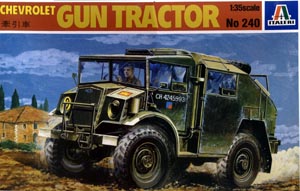 Armor
enthusiasts will find a couple of new releases to be of interest. In actual
fact, they're repops but they're new if you've never seen'em before. The
first kit in question is a 1/35 scale kit of the Chevrolet Gun Tractor
from ITALERI. Actually described
as a Field Artillery Tractor, the vehicle had four-wheel drive and was
the British answer to the problem of towing heavy guns. This particular
design was built by General Motors in Canada.
Armor
enthusiasts will find a couple of new releases to be of interest. In actual
fact, they're repops but they're new if you've never seen'em before. The
first kit in question is a 1/35 scale kit of the Chevrolet Gun Tractor
from ITALERI. Actually described
as a Field Artillery Tractor, the vehicle had four-wheel drive and was
the British answer to the problem of towing heavy guns. This particular
design was built by General Motors in Canada.
As for the kit, it's a typical ITALERI armor effort. Parts are molded in dark brown styrene and everything is thrown into a conventional top over bottom box without the use of a single protective bag. A small decal sheet provides markings for three different Canadian Field Artillery Regiments. Instructions are the usual foldout drawings-only style that's common to most if not all of ITALERI's kits, regardless of subjects. The sprue layouts that show which parts are not used in the particular kit are most helpful. On the other hand, the assembly section can leave you wondering exactly where some of the parts go. This is a result of the drawings-only approach, which is driven in large part by the need to communicate internationally. And drawings are a lot more efficient than doing complete text translations for every language where the kit is sold. Also cheaper.
For the most part, all of the parts are crisp with only a few showing flash or prominent parting lines. All in all, a very nice kit of a rather unusual subject. If you have an interest in British armor, you might want to pick up one of these before it goes out of production again. Nor is the price out of line at just $27.00.
If you're fascinated by the more…unique…afv designs, you might want
to think about adding this ITALERI kit of the Steyr RSO/01 Tractor to
your to do list. This odd looking little beast 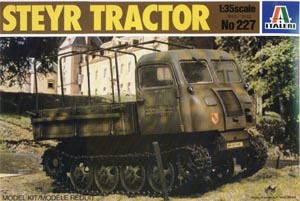 combined
a steel cab with a wood cargo bed and then perched the combination on
top of a set of tracks. Result? A tracked supply tractor that was used
mainly in the mud pit we called the Russian Front. During the rainy season,
tracked vehicles were about the only thing that could move!
combined
a steel cab with a wood cargo bed and then perched the combination on
top of a set of tracks. Result? A tracked supply tractor that was used
mainly in the mud pit we called the Russian Front. During the rainy season,
tracked vehicles were about the only thing that could move!
This is another 'new' kit that's actually a repop. As with the Chevrolet Gun Tractor, this is a typical ITALERI armor effort and is also in the standard 1/35 scale. Moldings are in dark brown styrene and nothing is bagged. But instead of a top over bottom box, this time ITALERI used an end flap box. Considering the number of minute parts usually associated with armor, I'd suggest you either tape over one of the end flaps or transfer all the parts to a spare conventional box.
Parts are crisp with little flash and the instructions, which utilize the usual international drawings-only format, are pretty easy to follow. Tracks are the open-ended rubber band type that have to be joined at the ends before installation. Decals provide markings for two different units and two color scheme options are illustrated on the instructions.
When sitting beside the usual gun-heavy tanks and half-tracks, the Steyr will stick out like a sore thumb. It also makes for a nice change of pace from the usual building schedule of one tank after another. Price? $27.00.
Seaplanes are not something you see too often in kit form. That alone
makes a couple of reissues from ITALERI get your attention. Both are in
1/72, carry an MSRP of $20.00 and were both originally produced over twenty
years ago under the 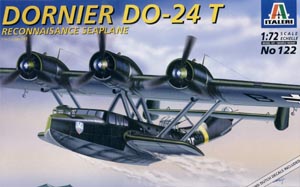 Supermodel
label.
Supermodel
label.
The D0-24T, a German tri-motored reconnaisance seaplane, runs to some 116 parts, everything but the clear molded in light gray. Parts are not bagged, but you do get a conventional top over bottom box. What's particularly interesting about this kit, especially considering it's age, is that all surface detail…including panel lines…are very lightly recessed. And be aware of the fact that some of the smaller parts are delicate enough that you will need to reacquaint yourself with a pair of quality tweezers!
Instructions are the familiar ITALERI style, but they've been updated by keying the recommended colors to the Model Master Acryl line. Decals include markings for German, Swedish and Dutch versions. There are no swastikas due to restrictions in Germany, so you'll need to pick up an aftermarket decal sheet of swastikas if you opt for the Luftwaffe version.
Italy produced quite a few seaplane designs and this kit focuses on the CANT Z.501 Gabbiano. Described as a bomber seaplane, how effective it was is another question. A small, single-engine design, it had a gun position in the nose, one aft of the wing and one in the top of the engine nacelle. Bomb load was one bomb under each wing…and small ones at that! Not surprising for an aircraft designed in 1934.
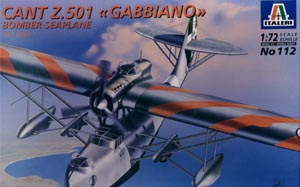 It's an
attractive little aircraft. Much of what I said about the Do-24T applies
here as well, with one major difference. Parts are nice and crisp with
no flash, but this time around the panel lines are raised. You do get
some nice fabric texture on the control surfaces that will tone down just
a tad with a couple of coats of paint. Again, a top over bottom box and
no bag for the parts.
It's an
attractive little aircraft. Much of what I said about the Do-24T applies
here as well, with one major difference. Parts are nice and crisp with
no flash, but this time around the panel lines are raised. You do get
some nice fabric texture on the control surfaces that will tone down just
a tad with a couple of coats of paint. Again, a top over bottom box and
no bag for the parts.
The Do-24T kit gives you a molded cradle to support the finished model. In the case of the Z.501, you get a very nice beaching dolly that combines with a support frame for the aft fuselage. Instructions are just like the Do-24T except that paint keys are for Model Master Enamels instead of Acryl. But when you consider that the FS numbers are the same whether enamel or acrylic, it's a moot point.
Decals allow you to build an aircraft belonging to the Italian Air Force in 1940, Italian Co-Belligerant Air Force in 1944 or the Italian Air Force Expeditionary Force that served in Spain, 1938, during the Spanish Civil War. All in all, a dandy little model that's definitely different.
Build models and you wind up with all kinds of tools. Knives, pliers, sanding blocks, files, you name it. Files, in particular, can cause some interesting problems. Most of the time we just pick up a file and have at it, but when it comes to mini files there are times when you have trouble handling the little boogers. For example, when you have an item in a vise and you need to use both hands to control the file. Mini files are a bit small for that trick…til now.
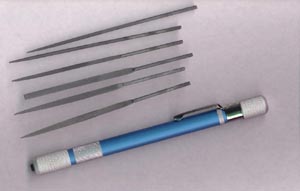 THE
TOOL MAN has a neat little item from EXCEL that'll solve the problem.
For $11.99, you get an aluminum handle and six mini files. One end of
the handle houses a mandrel (or chuck) to grip the butt of the file. On
the other, you'll find a screw-off cap. Inside the shaft of the handle
are the six mini files. No more "I can't find the files!" excuses.
THE
TOOL MAN has a neat little item from EXCEL that'll solve the problem.
For $11.99, you get an aluminum handle and six mini files. One end of
the handle houses a mandrel (or chuck) to grip the butt of the file. On
the other, you'll find a screw-off cap. Inside the shaft of the handle
are the six mini files. No more "I can't find the files!" excuses.
Anyway, the file styles provided are six of the most frequently used. You get a tapered triangular, tapered flat, tapered square, tapered half round, tapered round and straight flat.
When you combine the handle with the chosen file, your effective reach increases by a factor of two and a half. But more importantly, now you can use both hands for better control. The handle also has a clip built into it so you can carry it in your shirt pocket with no fear of losing it. And one final thing: It's made in the USA.
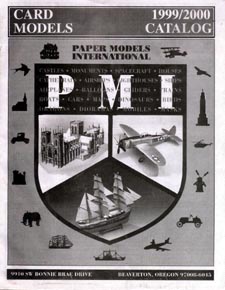 From time
to time, some readers have expressed interest in paper (or card) models.
Well, this is for you. The 1999/2000 catalog of PAPER
MODELS INTERNATIONAL is available. It runs to 56 pages and covers
almost any subject you'd care to mention. Detail on some of these models
(and they are models) reaches a level where you can't believe that it's
paper…and that's when you're staring at one from a foot away!
From time
to time, some readers have expressed interest in paper (or card) models.
Well, this is for you. The 1999/2000 catalog of PAPER
MODELS INTERNATIONAL is available. It runs to 56 pages and covers
almost any subject you'd care to mention. Detail on some of these models
(and they are models) reaches a level where you can't believe that it's
paper…and that's when you're staring at one from a foot away!
Whatever your pleasure, you'll probably find it. Castles, Christ of the Andes, windmills, buildings of every kind, H-O gauge trains (!), cars, aircraft, Zeppelins, ships that range from sailing ships to modern, armor, artillery, birds, blue whales, dinosaurs, even spacecraft.
I have a 1/32 B-17G that I'll report on later. Also a model of the Alamo that I haven't built and don't know when I will, mainly because it covers the entire Alamo compound and I don't have a place large enough to hold it…yet.
Last but certainly not least is a new publication that should get the attention of every serious aviation modeler. A new American model magazine has appeared. You're shocked? So was I...and delightfully so.
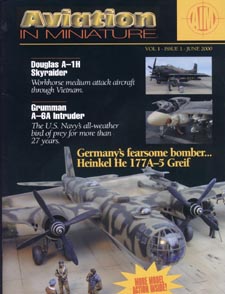 The
publication in question is (drum roll please) AIRCRAFT IN MINIATURE. I
first became acquainted with it at the 2000 IPMS/USA National Convention
and the same can probably be said for a significant percentage of those
in attendance.
The
publication in question is (drum roll please) AIRCRAFT IN MINIATURE. I
first became acquainted with it at the 2000 IPMS/USA National Convention
and the same can probably be said for a significant percentage of those
in attendance.
Published by WURGER PUBLICATIONS L.P., Alan Del Paggio is President and CEO (and also Editor-In-Chief of AIM). The magazine distinguishes itself in several ways, not the least of which is it's 8 1/2 x 12 format. This makes it similar but not identical to the European A4 format, gains valuable additional editorial space and allows it to stand above (by an inch) its competitors. It's also 100% color.
With 48 pages and a cover price of $13.95, it's a tad on the pricey side for now. However, keep in mind that this is the premiere issue (Vol. 1, No. 1, June 2000) and a quarterly besides. It's not unreasonable to assume that the page count will increase. Remember, four-color separations are not cheap.
So what's in the first issue? The cover story features the MPM 1/48 resin kit of the He-177 Greif. Other subjects include the ProModeler Me-410B-2/U-4, the Tri-Master 1/48 Ta-152C mixed media kit and more. Authors include Floyd S. Werner, jr., Sam Garcia and Brett Green to name a few.
Overall, the work is high quality and so is the photography. All of the projects in this issue are depicted in diorama settings and their stated goal is to continue this as much as possible. Aside from increasing the realism of the model, it also allows for the inclusion of support products that are only indirectly related to the specific aircraft.
While you won't find many step by step photos in this first effort (deadline pressures, you know), I've been told that they plan to expand that area considerably. They're also going to have an information page on Hyperscale. If you're champing at the bit to contact them, you can reach them by email.
Is there a future for a new model magazine from an American publisher? That, dear readers, is up to you. But if the answer isn't yes, then we have serious problems.
See you next month.




